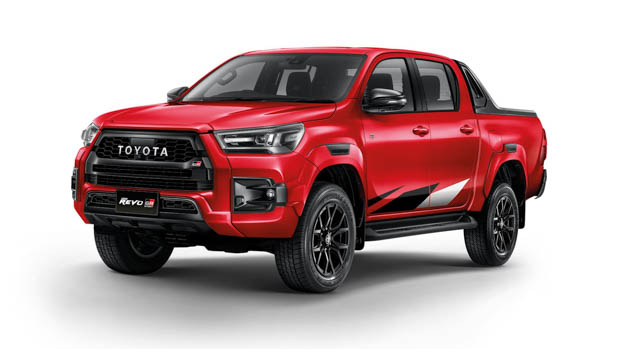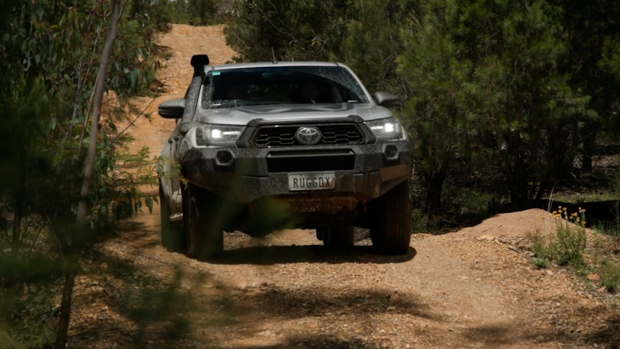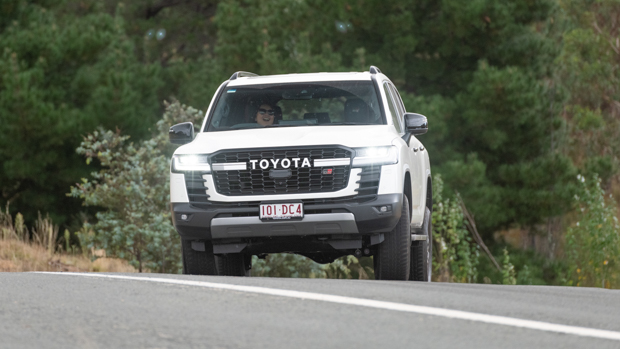-
Car Reviews
- Car News
-
Car Comparisons
Latest comparisons
- Chasing Deals
Toyota Australia says that a new ‘apex model’ is inbound, but what engine could power this particular model going forward?
A new flagship Toyota Hilux is incoming and will replace the Rugged X model that is currently still on sale here in Australia – with its manufacturer claiming the top-end variant will be an “apex” ute.
But the big question on people’s minds is: what sort of engine will be installed into the new Hilux flagship and where could this engine come from? And how successful will it be at baiting other “apex” utes – such as the new twin-turbo petrol V6 Ford Ranger Raptor?
Widespread suggestions that Toyota’s next Land Cruiser Prado will adopt an Everest-beating diesel V6 adopted from the brand’s new 300 Series could see a similar six-cylinder powertrain breathing new life into the ageing Hilux platform.
After all, with the new Ranger being available with diesel and petrol V6 power, and the related second-generation Amarok retaining a diesel V6, an “apex” ute with a 150kW four-cylinder diesel may not continue to cut-it with Australian buyers.
Chasing Cars is here to speculate on what this new engine could be, and whether the 2.8-litre turbo-diesel four-cylinder engine could be pushed to the side somewhat to cater for a likely larger and more powerful engine.
Here are the engine options Toyota could look at for the next Rugged X/ GR Sport model.
A powertrain option Toyota might lean towards with the next flagship Hilux is the 3.3-litre turbo-diesel V6 engine currently used in the Land Cruiser 300 Series here in Australia.
Its current outputs of 227kW/700Nm would be the perfect match for Toyota’s main Hilux competitors such as the Ford Ranger and Volkswagen Amarok, but weight and packaging could be an issue Toyota would have to address (and probably one they have fixed in secret, already!)
Codenamed F33A-FTV, the 3.3-litre engine is a heavy one at 266kg and uses a sequential pair of turbochargers to force boost into the cylinders. By using sequential turbochargers with variable vanes (just like a Porsche 911 Turbo S!), response in the low rpm range is improved, while high rpm performance is also improved, reducing engine lag.
Toyota already has the 3.4-litre V6 engine in production in the United States where it finds its home in the Toyota Tundra and Tundra hybrid as well as the Lexus LS500 and Toyota Land Cruiser (but not the Australian-delivered 300-Series Land Cruiser).
Interestingly, although marketed as a 3.5-litre V6, this engine is actually 3444cc, making it a 3.4-litre engine.
The 3.4-litre engine, a block that has the engine designation ‘V35A-FTS’, is twin-turbocharged and can produce up to 310kW of power and 650Nm of torque. It’s a 60-degree V6 engine which has electronically-controlled wastegates.
This V6 petrol engine is also available in hybrid specification in the Toyota Tundra, where the system is called ‘I-Force Max’. In this configuration, the twin-turbo V6 engine is aided by a 36kW electric motor housed within the 10-speed automatic transmission to produce total outputs of 326kW/790Nm.
Having already been launched in the US in hybrid form, this powertrain could help pave the way for a future generation of performance Hilux that runs partially on electric power, yet still has the range and versatility of a traditional diesel dual-cab ute.
While the Hilux has a generous engine bay that easily swallows the current neatly-packaged 1GD-FTV 2.8-litre four-cylinder diesel engine, both of Toyota’s new-generation V6 engines are far wider, larger, heavier units that would be a challenge to package.
The 3.4-litre twin-turbocharged V6 petrol engine, for one, places its turbochargers with one on each side of the engine close to the exhaust manifolds and uses electric wastegates to improve response.
The downside with this is that packaging is more of an issue, as the turbochargers are not mounted in the ‘hot vee’ or valley of the engine, creating less space side to side for the engine to sit on its mounts.
The 3.3-litre twin-turbo diesel V6 engine, however, mounts its turbochargers in the valley of the engine between the cylinder banks for greater responsiveness, but this also helps with packaging as the V6 engine is narrower and easier to place in the engine bay.
The 3.3-litre twin-turbo diesel V6 engine found in the new Toyota Land Cruiser 300 Series weighs a significant amount: 266kg to be exact. That is exactly 100kg more than the old 4.0-litre V6 that was installed in the Hilux back in the day.
Although the weight of the 3.4-litre twin-turbocharged petrol V6 engine is unknown at this stage, it would probably sit around the 240-260kg range.
The smaller displacement 2.8-litre turbo-diesel four-cylinder engine now found in the entire lineup of Toyota Hiluxes weighs just 131kg.
The question is not just that the twin-turbo V6 engines would physically fit within the space of the engine bay, but that their weight could be a challenge for designers and engineers at Toyota. Of course, local suspension development is one way Toyota could adapt the front end of the Hilux to take the weight of the 300 Series motor.
Reputationally, much now weighs on Toyota’s decision about where to take the Hilux ute. With sales of high-end, premium utes exploding in recent years, it’s clear that phoning it no longer cuts it with buyers.
The expensive tastes of Australian ute buyers have reverberated around the world, with local-led decisions on the Ford Ranger platform being adopted in other markets for that vehicle.
So, there’s a real opportunity here for Toyota, which has so far kept quiet about developments for its Hilux Rugged X flagship – apart to confirm that the “apex” variant is undergoing changes in the background.
Meanwhile, the company has cooked up – and released – a barrage of serious performance cars, from the first 86 coupe in 2012, to the GR Supra of 2019, the GR Yaris of 2020, and the forthcoming GR Corolla and second-gen GR86. Even the Land Cruiser 300 Series has a GR-Sport badged variant that focuses on suspension, not engine upgrades.
Performance dual-cab utes have become an increasingly profitable part of the automotive business here in Australia, led so far by the likes of the Ford Ranger Raptor, Volkswagen Amarok W580 and Nissan’s Navara PRO4 X Warrior, and of course, the current generation of Toyota Hilux.
Now, in 2022, Toyota Australia faces its biggest competitor, Ford Australia, as it comes towards launching its high-performance, twin-turbocharged V6-powered Ford Ranger Raptor and a new generation of Ranger and Everest coming later in 2022.
The Volkswagen Amarok, now on the shared Ranger platform, will also be launching soon, leaving Toyota in the shadows.
Now, more than ever, is the time for Toyota to bring out the big guns and step its Hilux range up to the next level.
Latest news
About Chasing cars
Chasing Cars reviews are 100% independent.
Because we are powered by Budget Direct Insurance, we don’t receive advertising or sales revenue from car manufacturers.
We’re truly independent – giving you Australia’s best car reviews.









